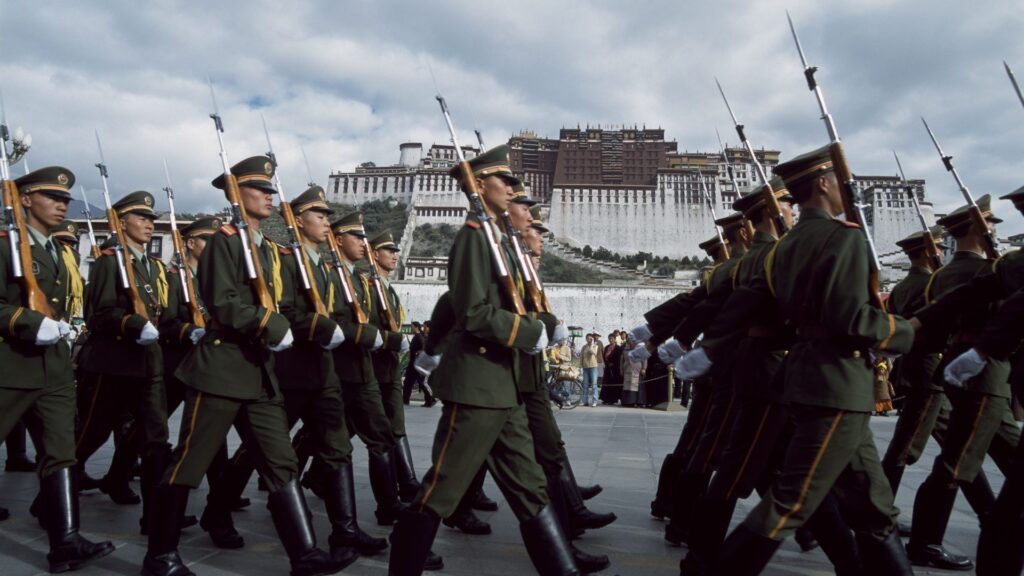Russia’s draft federal budget in 2024 earmarked nearly $1 billion over three years to complete its flagship nuclear icebreaker, the Rossiya. This state-of-the-art vessel is set to revolutionize Arctic shipping, enabling year-round navigation along Russia’s Northern Sea Route. At 48 meters wide, the Rossiya is designed to carve wide channels through thick ice that will now permit the safe passage of LNG carriers and oil tankers through the challenging waters of the East Siberian and Chukchi Seas. As China ramps up efforts to establish regular container shipping in the Arctic, the icebreaker may eventually escort cargo ships as well. With European markets increasingly inaccessible due to Western sanctions, the Leader-class icebreaker will be vital for transporting Russian energy resources to Asia, particularly China, during the winter months.
Russia has been reviving hundreds of Soviet-era military installations in the Arctic. At the same time, China is aggressively pursuing its vision of a new “Polar Silk Road.”
The reason for these new developments is rising temperatures. Global warming is fast causing ice packs to recede. Now, China in addition to new shipping routes, China is also eyeing the untapped mineral resources of the Arctic.
Russia and China have been cooperating to develop Arctic shipping routes, with Russia aiming to boost oil and gas exports to China amid Western sanctions, and China seeking an alternative route to reduce its reliance on the Strait of Malacca. Establishing these Arctic passages demands significant investment, and Russia has increasingly embraced Chinese funding and collaboration to help open and sustain the routes.
In January 2018, China unveiled its “Arctic Policy,” outlining its intent to “lawfully and rationally utilize Arctic resources.” Claiming the status of a “Near-Arctic State,” China has been a signatory of the Spitsbergen (Svalbard) Treaty since 1925, actively engaging in Arctic affairs.
In July, NewNew Shipping Line, a Chinese company, launched a new Arctic route connecting Shanghai to St. Petersburg, marking a significant step in the collaboration between China and Russia on the Northern Sea Route, or the “Ice Silk Road”. This development addresses China’s long-standing Malacca Strait dilemma, a critical vulnerability in its oil supply chain. 80% of China’s oil and gas imports and 60% of all the energy that China consumes is shipped through the narrow passage off the coast of Singapore. Should the US or India ever block the Strait of Malacca, China would face immediate and severe consequences– and the Northern Sea Route offers a strategic alternative to this, reducing both time and costs while enhancing China’s energy security.
For India, the Strait of Malacca represents a critical strategic asset, as it is the main passage for the majority of Chinese imports. This makes it a potential leverage point in the event of heightened tensions with Beijing, which has pursued over decades a policy to constrict India in a geostrategic chokehold in South Asia and beyond: the String of Pearls.
India’s position in the Indian Ocean, combined with its naval presence in the Andaman and Nicobar Islands at the strait’s entrance, gives New Delhi the wherewithal to block the waterway in the case of future Chinese aggressions.
Given that much of China’s oil imports—from the Persian Gulf, Venezuela, and Angola— pass through this route, India could create significant disruption. Beijing is acutely aware of this vulnerability and has poured enormous resources into overcoming it, including oil and gas pipelines running through Myanmar to connect the Bay of Bengal to southern China through the Kunming province. Similarly, with the development of the Arctic “Polar Silk Road,” China will cause New Delhi and Washington to rethink their security strategies to keep international trade free and open. Until now, both democracies have focused on matching Chinese advances in Indian and Pacific Oceans. The establishment of alternative routes, including through the Arctic, reduces the viability of using the Malacca Strait as a pressure point and gives China the opportunity to circumvent the two primary Indian Ocean powers, the United States and India. China has made significant strides in Arctic navigation, investing in icebreakers designed to ease access to new polar routes. In 2018, with assistance from Finnish firm Aker Arctic, China launched its first domestically built icebreaker, the Xue Long 2.
China’s Arctic policy, shared with Russia, presents several key contradictions. First, China must navigate the delicate balance of maintaining strong ties with Russia while also engaging with other Arctic nations. Second, China’s assertive actions in the Arctic could provoke conflict with the United States. Most significantly, China’s growing partnership with Russia could exacerbate US-China tensions. Over time, the strategic importance of the Strait of Malacca to China will diminish, particularly as China deepens its involvement in Arctic affairs and strengthens its cooperation with Russia in the region.







